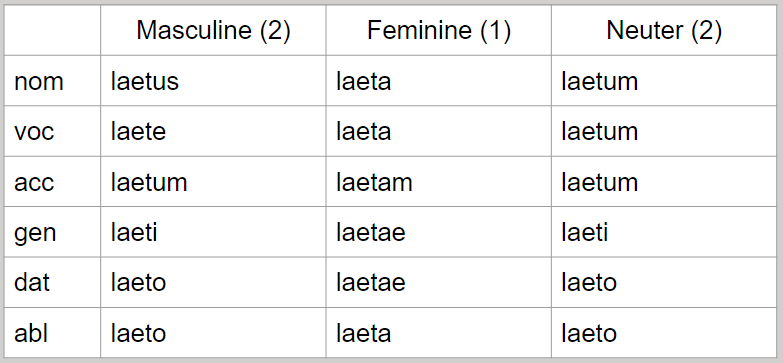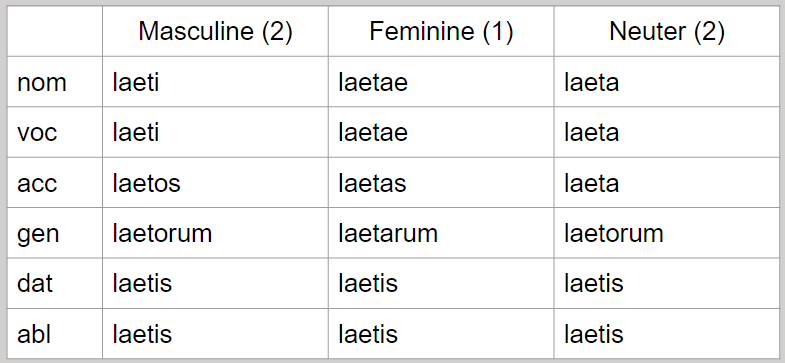Welcome back to Day 24 of the January Latin Challenge! So far this week we have been looking at Passive verbs, but this means we have started to broach a topic we haven’t covered yet - Adjectives! Let’s fix that now.
Day 24 and Day 25 are about the two types of adjectives in Latin: 2-1-2 adjectives and 3-3 adjectives.
Why are they called ‘2-1-2 adjectives’?
To be honest the name actually makes a lot of sense, but to understand it, lets just take a step back for one minute and remind ourselves what adjectives are.
Adjectives are words that describe nouns.
The happy girl, the sad dog, the tired man and so on. In English, they’re fairly easy, because they just go next to the noun they are describing.
In Latin, as I continue to harp on about, word order doesn’t matter. What matters are endings, and we use these to tell which noun the adjectives are describing.
In Latin, adjectives have to match the noun they are describing in
case,
number, and
gender.
This is super important, so remember it.
2-1-2 adjectives are ones like laetus. Now in your dictionary you might just see it as laetus, or you might see it written like this: laetus laeta laetum. This tells me its a 2-1-2 adjective because it has three different forms: for masculine nouns, for feminine nouns, and for neuter nouns.
laetus is what you would use to describe a masculine noun:
laetus puer - a happy boy
laetus dominus - the happy master
laeta is for feminine nouns:
laeta puella - the happy girl
laeta femina - the happy woman
laetum is for neuter nouns:
laetum bellum - the happy war
But those nouns were all nominative
Remember that adjectives have to match in case, number, and gender, so our adjective has to change its ending depending on what role the noun it describes is playing.
For this, you need to know the noun endings for the 1st and 2nd declension nouns. If you can’t remember, go and download my free Noun Endings Guide and have them to hand while practising 2-1-2 adjectives.
Masculine nouns
To make your adjective match masculine nouns, you follow the 2nd declension masculine table of noun endings. Take this sentence:
laetus puer puellam videt.
The happy boy sees the girl.
I use laetus puer - he is masculine, singular, and nominative.
If however, I have this sentence:
puella laetum puerum videt.
The girl sees the happy boy.
I have to use use laetum puerum - he is now accusative so my adjective has to change too.
Here are the endings for the singular and plural forms of laetus.
This is why the adjective type is called a 2-1-2 adjective. It follows the same noun endings as the 2nd declension masculine, the 1st declension (for feminine nouns), and the 2nd declension neuter.
Match the adjective to the noun
So let’s have a go at matching adjectives with their nouns. Here are 5 sentences. Which noun is being described by the adjective (in bold) in each sentence? Remember - word order doesn’t matter in Latin! Have a go, and read on when you are ready to find out the answers.
laetos amicos vidi.
vos feminae sunt laetae hodie.
rex a militibus laetis servatur.
nos laetum canem audivimus.
donum laetae puellae da!
Read on when ready
laetos is a masculine accusative plural, which matches amicos - a plural accusative with a masculine gender.
“I saw the happy friends”
laetae is a feminine ending, and it could be several cases. In this instance it is a plural nominative. It matches feminae -
“You women are happy today!”
laetis is a dative or ablative plural, and it could be any gender. So I need to look for a dative or ablative plural noun - militibus is the only one, so now I know it is masculine.
“The king is protected by happy soldiers”
laetum is either masculine or neuter, but it can’t be nominative as the verb audivimus is being done by “us”, not by a singular noun. So it must be accusative. This means it matches with canem - an accusative singular masculine.
“We heard the happy dog”
laetae again could be several cases. However, I have the verb da! which is an imperative. “Give the gift” (donum). So I assume this sentence is telling someone to give the gift TO someone - can I find a dative singular noun? Yes - puellae here is feminine, dative and singular. This matches a possible ending of laetae, and makes sense!
“Give the gift to the happy girl”
No more happiness
You can’t always just describe things as “happy” or our stories would get very boring. Here are some other examples of 2-1-2 adjectives. There are some oddities in there which I will explain, but just familiarise yourself with these common adjectives.
aequus aequa aequum - equal, fair
albus alba albus - white
altus alta altum - high, deep
bonus bona bonum - good
magnus magna magnum - large, huge
malus mala malum - bad
miser misera miserum - poor, unfortunate, wretched
pulcher pulchra pulchrum - beautiful, handsome
Now the last two, miser and pulcher look a bit different from the others. They don’t have the classic -us -a -um endings. They have -r -a -um. However, the principle is the same. The main thing to be aware of is that other than the nominative and vocative masculine singular, the -e- is dropped and the -r contracts into the stem for the rest of the genders and cases. The endings attach onto this -r as normal.
So to sum up: a 2-1-2 adjective is just the name we give to a group of adjectives that change to match their noun by using the 2nd declension endings for masculine nouns, the 1st declension endings for feminine nouns, and the 2nd neuter endings for neuter nouns. If you are struggling at all with these endings, do go and download my free Noun Endings Guide.
And that’s a quick overview of 2-1-2 adjectives! I hope it helped - let me know if you have questions in the comments, and I’ll see you tomorrow on bambasbat for Day 25 of the January Latin Challenge!




